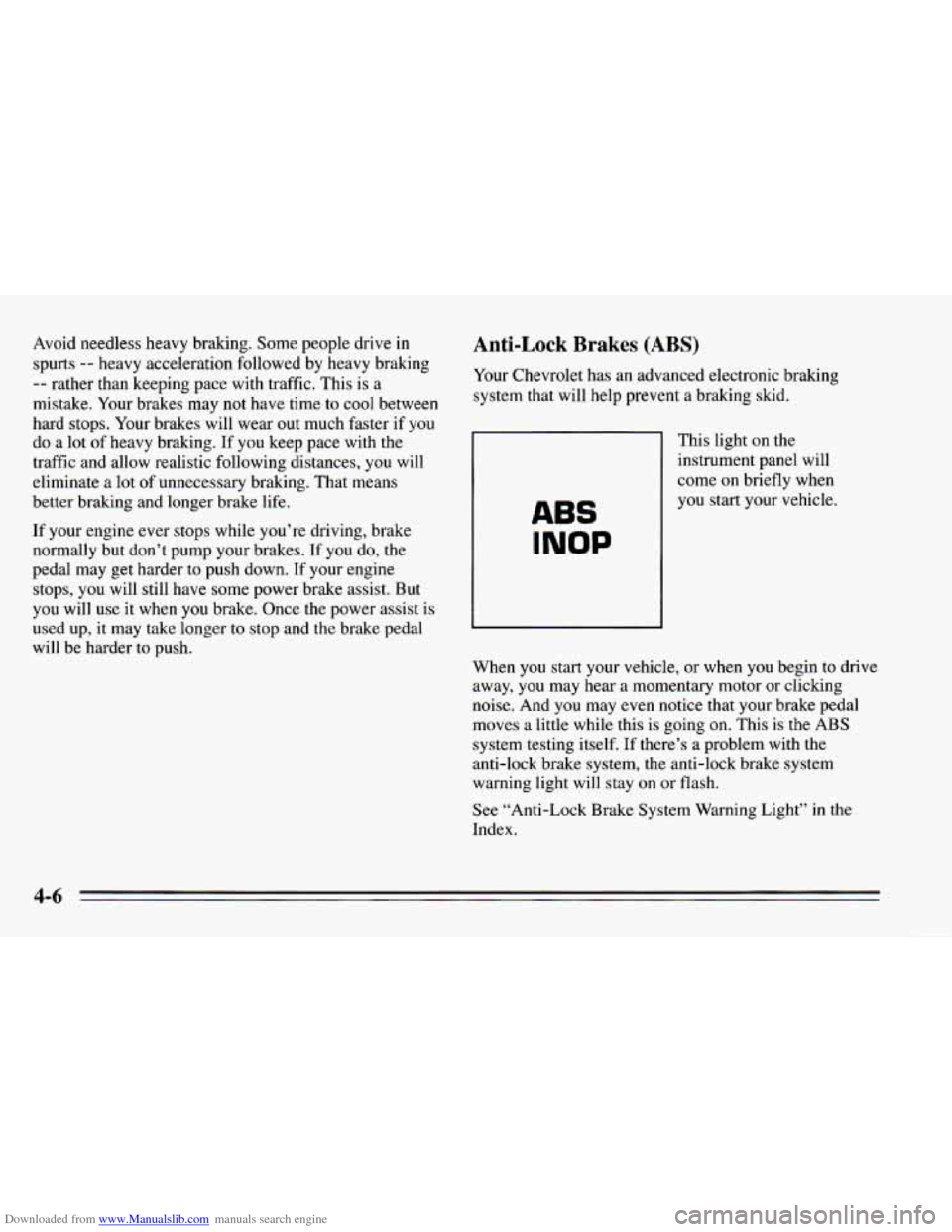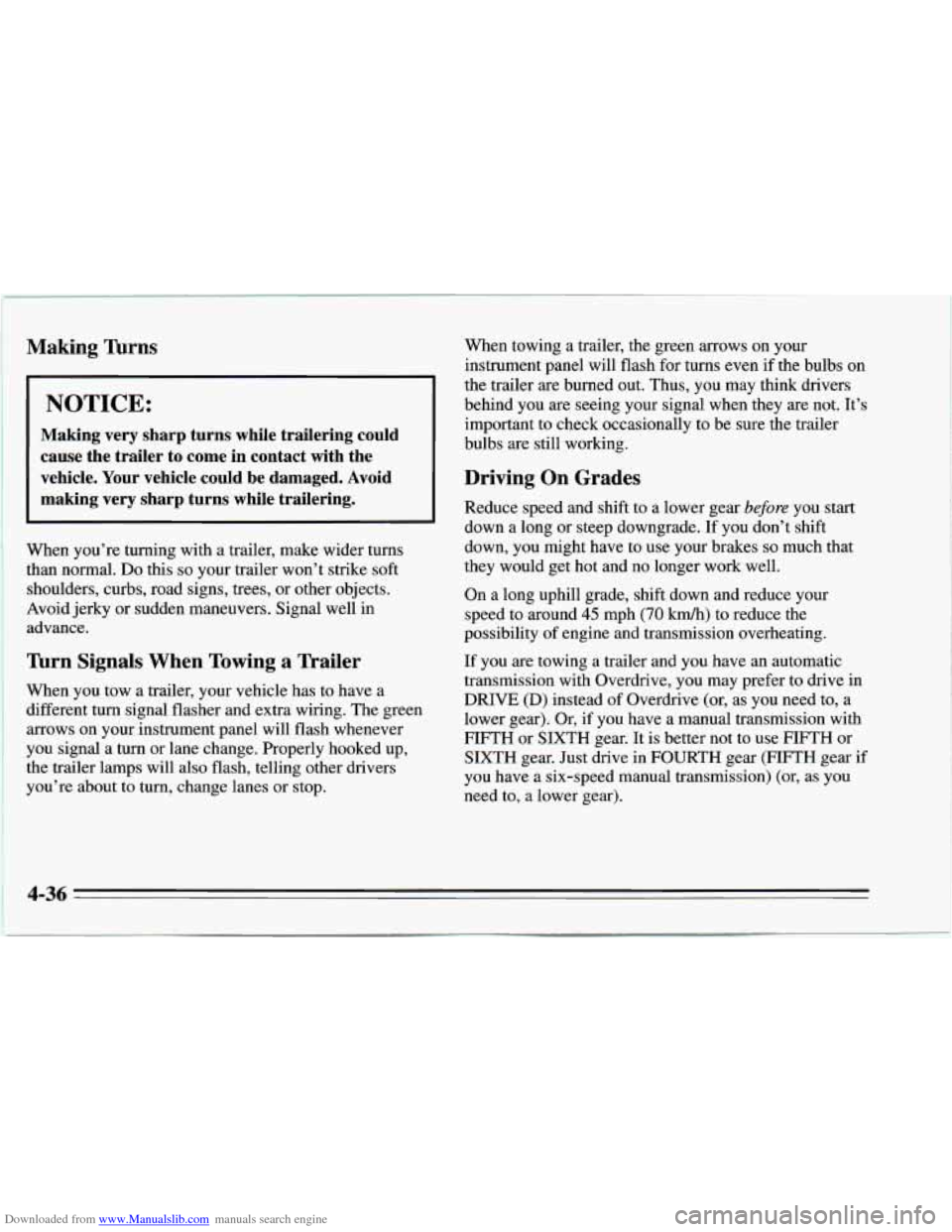Page 91 of 388
Downloaded from www.Manualslib.com manuals search engine A green arrow on the
instrument panel will flash
in the direction of the turn
or lane change.
To signal a lane change, just raise or lower the lever
until the green arrow starts to flash. Hold it there until
you complete your lane change. The lever will return by
itself when you release it.
As you signal a turn or a lane change, if the arrows don’t
flash but just stay
on, a signal bulb may be burned out
and other drivers won’t see your turn signal.
If a bulb is burned out, replace it to help avoid an
accident.
If the green arrows don’t go on at all when you
signal a turn, check the fuse (see “Fuses” in the Index).
Headlamp High-Low Beam
To change the headlamps
from low beam to high or
high to low, pull the turn
signal lever all the way
toward
you. Then release it.
When the high beams are
on, this blue light on the
instrument panel also will
be
on.
2-39
Page 99 of 388
Downloaded from www.Manualslib.com manuals search engine Lamps
Main Lamp Control
The main lamp control is a knob that works these lamps:
0 Headlamps
0 Taillamps
0 Parking lamps
0 License lamps
Sidemarker lamps
0 Instrument panel lamps
8 I Turn the knob to this position to turn on your
headlamps and other operating lamps.
pf Turn the knob to this position to turn on your
parking lamps without your headlamps
-’Q-
Turn the knob to OFF to turn off the lamps.
Lamps On Reminder
If you turn the ignition “Off’ and leave the lamps on,
you will hear a chime when you open the driver’s door.
2-47
Page 100 of 388

Downloaded from www.Manualslib.com manuals search engine Brightness Control
This switch controls the brightness of your
instrument panel lights. Turn the switch to brighten or
dim the lamps.
If you turn the switch all the way up,
your courtesy lamps will come on.
Daytime Running Lamps (Canada)
Daytime Running Lamps (DRL) make it easier to see
the front
of your vehicle during the day. DRL can be
helpful when it’s raining and in the short periods after
dawn and before sunset.
A light sensor on top of the instrument panel makes the
DRL work,
so be sure it isn’t covered.
The DRL system will make your front turn signal lamps
come on
when:
0 The ignition is on
The headlamp switch is off, and
0 The parking brake is released.
When the DRL are on,
only your front turn signal lamps
will be on. The taillamps, sidemarker
and other lamps
won’t be
on. Your instrument panel won’t be lit up either.
When
it’s dark enough outside, your front turn signal
lamps will go
out and your headlamps will come on.
The other lamps that come on with your headlamps will
also come
on.
When it’s bright enough outside, the regular lamps will
go off, and your front turn signal lamps come on.
As with any vehicle, you should turn on the regular
headlamp system any time you need
it.
2-48
Page 116 of 388
Downloaded from www.Manualslib.com manuals search engine Instrument Panel
P
2-64
Page 118 of 388
Downloaded from www.Manualslib.com manuals search engine Instrument Panel and Cluster
Your instrument cluster is designed to let you know at a
glance how your vehicle is running. You’ll
know how
fast you’re going, about how much fuel you have left and
many other things you’ll need
to know to drive
safely and economically.
2-66
Page 121 of 388

Downloaded from www.Manualslib.com manuals search engine Air Bag Readiness Light
There is an air bag readiness light on the instrument
panel, which shows
AIR BAG.
AIR BAG
The system checks the air
bag’s electrical system for
malfunctions. The light
tells you if there is an
electrical problem.
The system check includes the air bag sensors and
modules, the wiring and the diagnostic module. For
more information on the
air bag system, see “Air Bag”
in the Index.
You will see this light flash for a few seconds when you
turn your ignition to
RUN or START. Then the light
should go out. This means the system is ready.
If the
air bag readiness light doesn’t come on when you
start your vehicle, or stays on, or comes on when you
are driving, your air bag system may not work properly.
Have your vehicle serviced right away.
Brake System Warning Light
Your Chevrolet’s hydraulic
brake system is divided into
two parts. If one part isn’t
working, the other part
can
still work and stop you. For
good braking, though, you
need both parts working
well.
If the warning light comes on, there could be a brake
problem. Have your brake system inspected right away.
This light should come on briefly as you start the
vehicle.
If it doesn’t come on then, have it fixed so it
will be ready
to warn you if there’s a problem.
If the light comes on while you are driving, pull
off the
road and stop carefully. You may notice that the pedal is
harder to push. Or, the pedal may go closer to the floor.
It may take longer to stop. If the light
is still on, or if the
anti-lock brake system warning light is flashing, have
the vehicle towed for service. (See “Anti-Lock Brake
System Warning Light” and “Towing Your
Car” in the
Index.)
2-69
Page 162 of 388

Downloaded from www.Manualslib.com manuals search engine Avoid needless heavy braking. Some people drive in
spurts
-- heavy acceleration followed by heavy braking
-- rather than keeping pace with traffic. This is a
mistake. Your brakes may
not have time to cool between
hard stops. Your brakes will wear out much faster if
you
do a lot of heavy braking. If you keep pace with the
traffic and allow realistic following distances, you will
eliminate a lot
of unnecessary braking. That means
better braking and longer brake life.
If your engine ever stops while you’re driving, brake
normally but don’t pump your brakes.
If you do, the
pedal may get harder to push down. If your engine
stops, you will still have some power brake assist. But
you will
use it when you brake. Once the power assist is
used up, it may take longer to stop and the brake pedal
will be harder
to push.
Anti-Lock Brakes (ABS)
Your Chevrolet has an advanced electronic braking
system that will help prevent a braking
skid.
ABS
INOP
This light on the
instrument panel will
come on briefly when
you start your vehicle.
When
you start your vehicle, or when you begin to drive
away, you may hear a momentary motor or clicking
noise. And you may even notice that your brake pedal
moves a little while this is going on. This is the ABS
system testing itself. If there’s a problem with the
anti-lock brake system, the anti-lock brake system
warning light will stay
on or flash.
See “Anti-Lock Brake System Warning Light”
in the
Index.
Page 192 of 388

Downloaded from www.Manualslib.com manuals search engine Making ’hrns When towing a trailer, the green arrows on your
instrument panel will flash for turns even if the bulbs on
the trailer are burned out. Thus, you may think drivers
NOTICE: behind you are seeing your signal when they are not. It’s
Making very sharp turns while trailering could
cause the trailer to come in contact with the
vehicle. Your vehicle could be damaged. Avoid important to check occasionally to be sure the trailer
bulbs
are still working.
Driving On Grades
making very sharp turns while trailering. Reduce speed and shift to a lower gear before you start
down
a long or steep downgrade. If you don’t shift
When you’re turning with a trailer, make wider turns
than normal.
Do this so your trailer won’t strike soft
shoulders, curbs, road signs, trees, or other objects.
Avoid jerky or sudden maneuvers. Signal well in
advance.
Turn Signals When Towing a Trailer
When you tow a trailer, your vehicle has to have a
different turn signal flasher and extra wiring. The green
arrows on your instrument panel will flash whenever
you signal a turn or lane change. Properly hooked up,
the trailer lamps will also flash, telling other drivers
you’re about to turn, change lanes or stop. down,
you might have to use your brakes
so much that
they would get hot and no longer work well.
On a long uphill grade, shift down and reduce your
speed to around
45 mph (70 km/h) to reduce the
possibility
of engine and transmission overheating.
If you are towing a trailer and you have an automatic
transmission with Overdrive, you may prefer to drive in
DRIVE (D) instead of Overdrive (or, as you need to, a
lower gear). Or, if you have a manual transmission with
FIFTH or SIXTH gear. It is better not to use FIFTH or
SIXTH gear. Just drive in FOURTH gear (FIFTH gear
if
you have a six-speed manual transmission) (or, as you
need to, a lower gear).
4-36